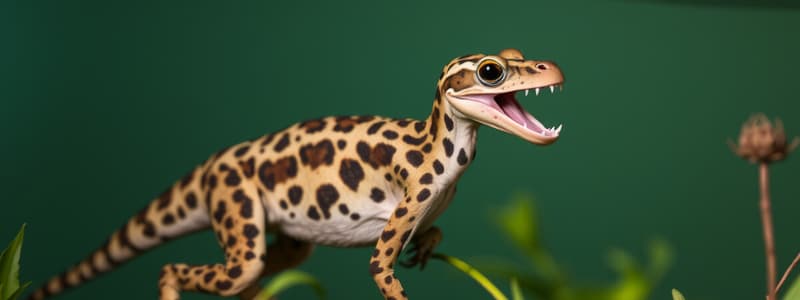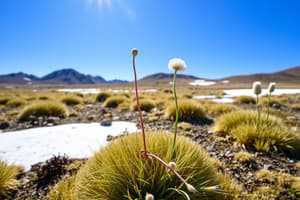Podcast
Questions and Answers
What is adaptation for survival?
What is adaptation for survival?
Characteristics that help living organisms to survive and reproduce in their ecosystem.
Which of the following is a habitat for living organisms?
Which of the following is a habitat for living organisms?
- Desert
- Ocean
- Forest
- All of the above (correct)
A predator is an animal that is eaten.
A predator is an animal that is eaten.
False (B)
The _____ is an area where living and non-living things interact.
The _____ is an area where living and non-living things interact.
What color fur does the camel have?
What color fur does the camel have?
What unique ability do bull sharks have?
What unique ability do bull sharks have?
Match the following adaptations with their descriptions:
Match the following adaptations with their descriptions:
Lizards are mammals.
Lizards are mammals.
The process of breaking down food into smaller parts is called _____ process.
The process of breaking down food into smaller parts is called _____ process.
What are the two systems that work together to provide energy from food?
What are the two systems that work together to provide energy from food?
What is a characteristic of sandy soil in deserts?
What is a characteristic of sandy soil in deserts?
Flashcards are hidden until you start studying
Study Notes
Adaptation for Survival
- Adaptation refers to characteristics that enable living organisms to survive and reproduce in their ecosystems.
- Camels have thick hairy skin to shield them from the desert's extreme heat.
- Palm trees possess strong roots to anchor them against strong desert winds.
Ecosystems and Habitats
- An ecosystem is a community where living and non-living entities interact.
- A habitat is the specific environment where organisms reside.
Predator and Prey
- Predators are animals that hunt and consume other animals (prey).
- Example: Polar bears hunt seals in the Arctic regions.
Types of Adaptation
- Examples of adaptations include camouflage in species like the fennec fox, which has tan-colored fur for blending into sandy environments.
- Some animals, such as bull sharks, have the unique ability to thrive in both fresh and saltwater due to their physiological adaptations.
Plant Adaptation
- Acacia trees can produce toxins in their leaves as a defense strategy to deter herbivores.
- Plants in tropical rainforests face competition for light due to tall tree growth, some reaching heights of 70 meters.
Digestive System
- A system consists of organs working together for specific functions; the digestive system processes food to extract energy.
- The digestion process involves breaking down food into absorbable nutrients primarily in the small intestine.
- Nutrients include vitamins and proteins, vital for energy, growth, and bodily functions.
- Undigested food passes to the large intestine, where the body may not benefit from it.
Studying That Suits You
Use AI to generate personalized quizzes and flashcards to suit your learning preferences.




